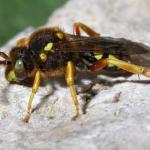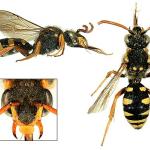Apis agitabilis HARRIS 1776; Apis vespoides SCHRANK 1781; Apis gallica VILLERS 1789; Apis lunulata VILLERS 1789; Apis connexa KIRBY 1802; Apis schaefferella KIRBY 1802
South Devon; formerly recorded from a number of counties in southern England. Not found in Ireland. Widely distributed in southern and central Europe, becoming scarcer in the north.
Nationally endangered (RDB1) in Britain (Else & Spooner in Shirt 1987). Also given as an RDB1 species by Falk (1991). The species is currently known from only a single coastal site in south Devon. There were no British records of this very large Nomada from about 1925 until 1975, in which year G M Spooner recorded the species from this site, flying within the nesting areas of Eucera longicornis. The population there of N. sexfasciata is small and apparently stable. It occurs along much of the cliffs in this locality (A. Stubbs, pers. comm.).
Shares the same habitats as its hosts, Eucera longicornis and, perhaps formerly, E. nigrescens (this association is known on mainland Europe but has not been reported from Britain).
Univoltine, late May to mid July, rarely August.
A cleptoparasite of Eucera longicornis and E. nigrescens (Stöckhert 1933; Westrich 1989), though only the former species is a known host bee in Britain, the Nomada having been found inside a cell of this Eucera (Smith 1843).
In Britain, the species has been observed visiting bloody crane’s-bill (Geranium sanguineum), sow-thistle (Sonchus sp.) (G M Spooner, pers. comm.), and kidney vetch (Anthyllis vulneraria)(S P M Roberts, pers. comm.).
None recorded.
Profile written:
Proofed: 22 December 2011



